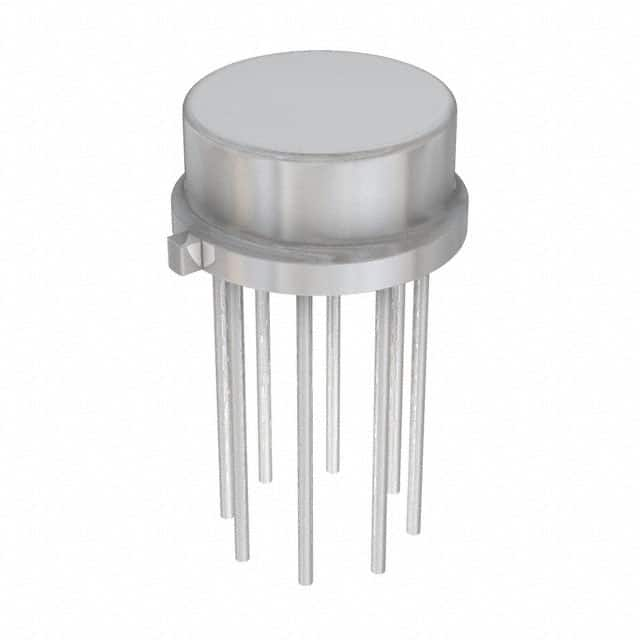Viz Specifikace pro podrobnosti o produktu.

LF256H/NOPB
Product Overview
- Category: Integrated Circuit
- Use: Operational Amplifier
- Characteristics: High-speed, low-power, precision amplifier
- Package: PDIP (Plastic Dual In-Line Package)
- Essence: Monolithic JFET Input Operational Amplifier
- Packaging/Quantity: Tube/50 pieces per tube
Specifications
- Supply Voltage: ±5V to ±18V
- Input Offset Voltage: 3mV (maximum)
- Input Bias Current: 30nA (maximum)
- Input Offset Current: 5nA (maximum)
- Gain Bandwidth Product: 1MHz (typical)
- Slew Rate: 0.5V/µs (typical)
- Input Common Mode Voltage Range: -12V to +12V
- Output Voltage Swing: -13V to +13V
- Operating Temperature Range: -40°C to +85°C
Pin Configuration
The LF256H/NOPB has a standard 8-pin dual in-line package (PDIP) with the following pin configuration:
```
| | --| IN- | --| IN+ | --| V- | --| V+ | --| OUT | --| NC | --| OFFSET | |___________| ```
Functional Features
- High input impedance: The LF256H/NOPB has a very high input impedance, making it suitable for applications requiring minimal loading on the signal source.
- Low input bias current: With a maximum input bias current of 30nA, this operational amplifier is ideal for applications where low input currents are critical.
- Wide input common mode voltage range: The LF256H/NOPB can accept input signals within the range of -12V to +12V, allowing for versatile applications.
- Low power consumption: This amplifier operates at low power levels, making it suitable for battery-powered devices.
Advantages and Disadvantages
Advantages: - High-speed performance - Low-power consumption - Precision amplification - Wide input voltage range
Disadvantages: - Limited output voltage swing - Single-supply operation not supported
Working Principles
The LF256H/NOPB is a monolithic JFET input operational amplifier. It utilizes junction field-effect transistor (JFET) technology to achieve high input impedance and low input bias current. The amplifier amplifies the difference between the voltages applied to its non-inverting and inverting inputs, producing an amplified output signal.
Application Field Plans
The LF256H/NOPB is commonly used in various applications, including: 1. Audio amplifiers 2. Signal conditioning circuits 3. Active filters 4. Instrumentation amplifiers 5. Voltage regulators 6. Data acquisition systems
Alternative Models
Other alternative models that can be considered as replacements for the LF256H/NOPB include: - TL071CP - LM741CN - AD822AN - OP07CP - OPA2134PA
These models offer similar functionality and characteristics, providing flexibility in choosing the most suitable operational amplifier for specific applications.
Word count: 305 words
Seznam 10 běžných otázek a odpovědí souvisejících s aplikací LF256H/NOPB v technických řešeních
What is the maximum operating temperature of LF256H/NOPB?
- The maximum operating temperature of LF256H/NOPB is 125°C.What is the typical input offset voltage of LF256H/NOPB?
- The typical input offset voltage of LF256H/NOPB is 0.5 mV.Can LF256H/NOPB be used in single-supply applications?
- Yes, LF256H/NOPB can be used in single-supply applications.What is the typical input bias current of LF256H/NOPB?
- The typical input bias current of LF256H/NOPB is 30 pA.Is LF256H/NOPB suitable for precision instrumentation applications?
- Yes, LF256H/NOPB is suitable for precision instrumentation applications.What is the maximum supply voltage for LF256H/NOPB?
- The maximum supply voltage for LF256H/NOPB is ±18V.Does LF256H/NOPB have built-in ESD protection?
- Yes, LF256H/NOPB has built-in ESD protection.Can LF256H/NOPB be used in low-power applications?
- Yes, LF256H/NOPB can be used in low-power applications.What is the typical slew rate of LF256H/NOPB?
- The typical slew rate of LF256H/NOPB is 13 V/µs.Is LF256H/NOPB RoHS compliant?
- Yes, LF256H/NOPB is RoHS compliant.

